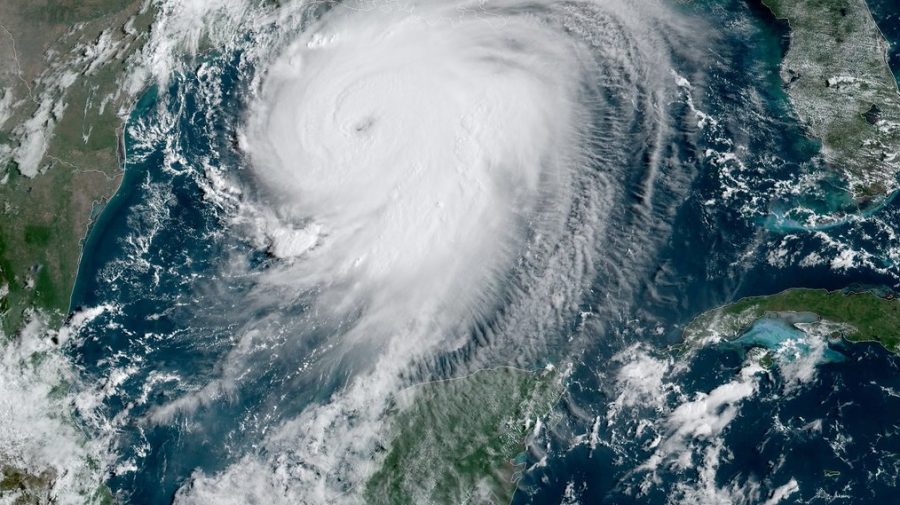Hurricane Season 2020 is One for the Record Books
Back-to-back storms and the COVID-19 Pandemic add to challenges for relief and recovery
Hurricane Laura hit on heels of other storms bringing high winds and flooding, and extra challenges to the relief efforts.
September 28, 2020
As if 2020 wasn’t hard enough to get through with the Covid-19 pandemic that stormed across the nation, then the hurricane season struck.
On Aug. 26, Hurricane Laura struck Louisiana just 15 years after the devastation of Hurricane Katrina. Louisiana’s neighboring states like Texas and Arkansa and even off land U.S. territories like Puerto Rico and Cuba have all been heavily impacted by Laura as well. The category 4 hurricane left a lasting scar.
By the evening of Aug. 29, more than 485,192 residents in Louisiana, 106,801 in Texas, and 26,373 in Arkansa continued to have no electricity according to poweroutage.us. 87 water systems remained inoperable leaving 150,000 Louisiana residents with no running water. Officials have warned residents of the coming weeks without water and power.
Explained by ABC News, due to the lack of water and electricity, hospitals and nursing homes had no choice but to evacuate patients to other facilities. In Lake Charles Memorial, Louisiana 146 people with 19 babies in the NICU had to be transferred elsewhere. Having no water meant that there was no air conditioning. This limits the hospital’s capability to sterilize equipment and cleanse the entirety of the building. In these times of the pandemic, cleansing is crucial. Without it, both staff and patients will not be able to get the proper amount of sterilization they need to protect themselves.
On that evening, the remains of Hurricane Laura made its way up North and to the East coast. A flash flood of 3 to 5 inches appeared in Arkansas, Mississippi, Alabama, Tennessee, and Southern Illinois. It brought threats of gusty winds and a few tornadoes to the Mid-Mississippi and Ohio Valley. To the Northeast, heavy rain and flash flood warnings.
Through satellite images on The Weather Channel, you can see the before and after shots after Laura in Louisiana. You can find in Cameron, Louisiana the homes and fields that were once whole, now disappeared. The debris of what little is left of schools and the airport are now scattered around the area.
Despite Laura not being as destructive as most predicted, Lake Charles, Louisiana had winds up to 137 mph that had ripped through the area. The winds were so strong that train cars in Grand Lake, Louisiana, 40 miles north of Cameron, tipped over.
As of August 29, the hurricane has taken 16 lives, according to ABC News. Half of them reported to be by Carbon monoxide poisoning of operating power generators. Then another nearly 2 dozen lives were lost in Haiti and the Dominican Republic on its way to the U.S. Gulf Coast.
Comparing Hurricane Laura to other Gulf Coast hurricanes it’s high up there in the ranking. In the last 120 years there have been so many hurricanes.
For all continental U.S. landfalling Hurricanes, Laura is tied for fifth to being the strongest ever to hit the U.S. Pressure-wise. This made Laura the fourth strongest to hit in U.S. history. The highest wind recorded was 150 mph, the strongest storm to hit Louisiana since 1856.
The most intense hurricane was Hurricane Camille. It struck Waveland, Mississippi in Aug. 17, 1969 and was deemed the most powerful storm to make landfall on the Gulf Coast based off of the Saffir-Simpson hurricane wind scale. Camille is one of only four hurricanes ever to hit the U.S. as a Category 5 storm. By National Public Radio (NPR), according to the National Weather Service, “‘The actual maximum sustained winds of Hurricane Camille are not known as the hurricane destroyed all the wind-recording instruments in the landfall area.’” However it was later discovered that there were high winds up to roughly 175 mph.
As for the deadliest, it was The Great Galveston Hurricane of Sept. 8, 1900 that landed in the Texas coast. It had similar strength to Laura at high winds up to 150 mph. NPR’s John Burnett said in 2017, “Forecasting was primitive in those days — they relied on spotty reports from ships in the Gulf Coast…[they] had no idea that it was a monster”. The estimated death toll ranges from 6,000 to 12,000 people on Galveston Island and mainland.
Lastly, the costliest U.S. hurricane was Hurricane Katrina back in Aug. 29 2005 that hit New Orleans. It has been said to be not only the costliest but the most expensive natural disaster of them all in U.S. history, by the National Oceanic and Atmospheric Administration. The disaster cost the estimated $160 billion worth of damage and furthering the wreckage it lost 1,836 lives and left millions of others homeless. Despite it only being a Category 3 hurricane, it was still able to submerge 80% of New Orleans.
The road to recovery may be a long one for those by the Gulf Coast for these next few weeks. Not only do they have to worry about recovery in general but they have to do it amidst a pandemic.
In Orange, Texas hundreds of cars, hundreds of families waiting in the extreme heat for basic needs: ice, water, and a warm meal at local supermarkets that turned into aid distribution centers. In food lines volunteers wore face shields and asked that car windows were rolled up.
In Louisiana, according to NPR, The Red Cross had said it received numerous calls ever since the disaster. Gyms and stadiums were turned into shelters for those in need. However, with the alarming rise of coronavirus cases there prior to the hurricane those shelters may become a threat. Due to that, there have been much less shelters in Louisiana than past years. It was advised by emergency officials to go seek shelter in New Orleans, roughly 200 miles east of Lake Charles, for those who needed it.
Drew Brown, Regional Communications & Marketing Manager from American Red Cross of Illinois, has stated that “right now in our Illinois region, we have 56 volunteers that are deployed across the country” which includes down in Louisiana and Texas after Hurricane Laura. They have even sent volunteers to the Bahamas along with other ongoing missions down there.
They were able to put up disaster shelters and help with disaster assessments; they go through neighborhoods to check the damage and search for those who need help. Local partners have also teamed up with Red Cross to distribute cleanup supplies and food meals for people.
However, Brown addressed that “safety is top priority.” They highly “encourage people that if you want to volunteer you need to assess your health needs to your doctor.”
Rescue and search teams down in Louisiana have struggled to both protect themselves and search for survivors. On NPR, Michael Kimble, who is in charge of Louisiana’s search and rescue teams says, “COVID brings it to a whole new level.” His crews do daily COVID-19 screenings and temperature checks while wearing personal protective equipment (PPE) to protect themselves. Though if they rescue people from the wreckage to their boats and trucks there is no way of knowing whether they’re not exposing themselves to COVID.
Furthermore Louisiana officials warned that COVID-19 testing has been put on hold for the time being. Which means that tracking data of how evacuees and those returning spread the virus will be limited.
Through this all, local cities like New Orleans that were untouched were able to come together to aid those were. On Eater New Orleans, chef Amy Sins and her Flood and Disaster Outreach group collaborated with: regional food bank system Second Harvest, local restaurants, and others to prepare, package and distribute meals to Lake Charles residents and evacuees in New Orleans.
On Sept. 20, 2017 another devastating hurricane, Hurricane Maria, blew through the Caribbean Islands which to this day are still recovering from the disaster.
The U.S. territory island Puerto Rico took the heaviest damage with 2,975 lives lost in the hurricane. By Mercy Corps, 100% of electricity on the island was lost making it the largest blackout in U.S. history. It took nearly a year for the power to be restored to everyone. 80% of crop value was lost as well. ¼ of the public school there had to be shut down. Roughly 130,000 people had to evacuate the country, that’s 4% of Puerto Rico’s population.
The Federal Emergency Management Agency (FEMA) was one of the many corporations that provided aid to those down in Puerto Rico. For the last 3 years, FEMA had obligated “$152 million over the past three years for a total of 116 projects at 15 higher education institutions in Puerto Rico” according to Caribbean Business. $47 million of the funding went to 21 permanent work projects which was said to benefit thousands of students on the island.
Back in 2019 after Hurricane Urma and Maria hit Puerto Rico “the federal government allocated more than $43 billion dollars for the recovery. Of that money, only $21 billion has been “obligated” or earmarked for specific tasks, and only $14 billion has been disbursed — or less than 33 percent” according to the Miami Herald. Compared to Florida, $10.8 billion was distributed to the state after Irma and Maria, and $8.5 billion has been obligated and $5.6 billion has been donated.
However, disasters like, earthquakes and most recently Tropical Storm Isaias, after Hurricane Maria dragged the recovery process even longer. With COVID-19, “it presented higher risks of transmitting the disease” warned by The Centers for Disease Control and Prevention. There has been a spike in confirmed cases due to Puerto Ricans seeking shelters during Tropical Storm Isaias.
Now in 2020, day-long power outages happen from time to time in rural areas. There are some homes seen with tarps rather than roofs. Fallen down utility poles and uprooted trees are very common now.



